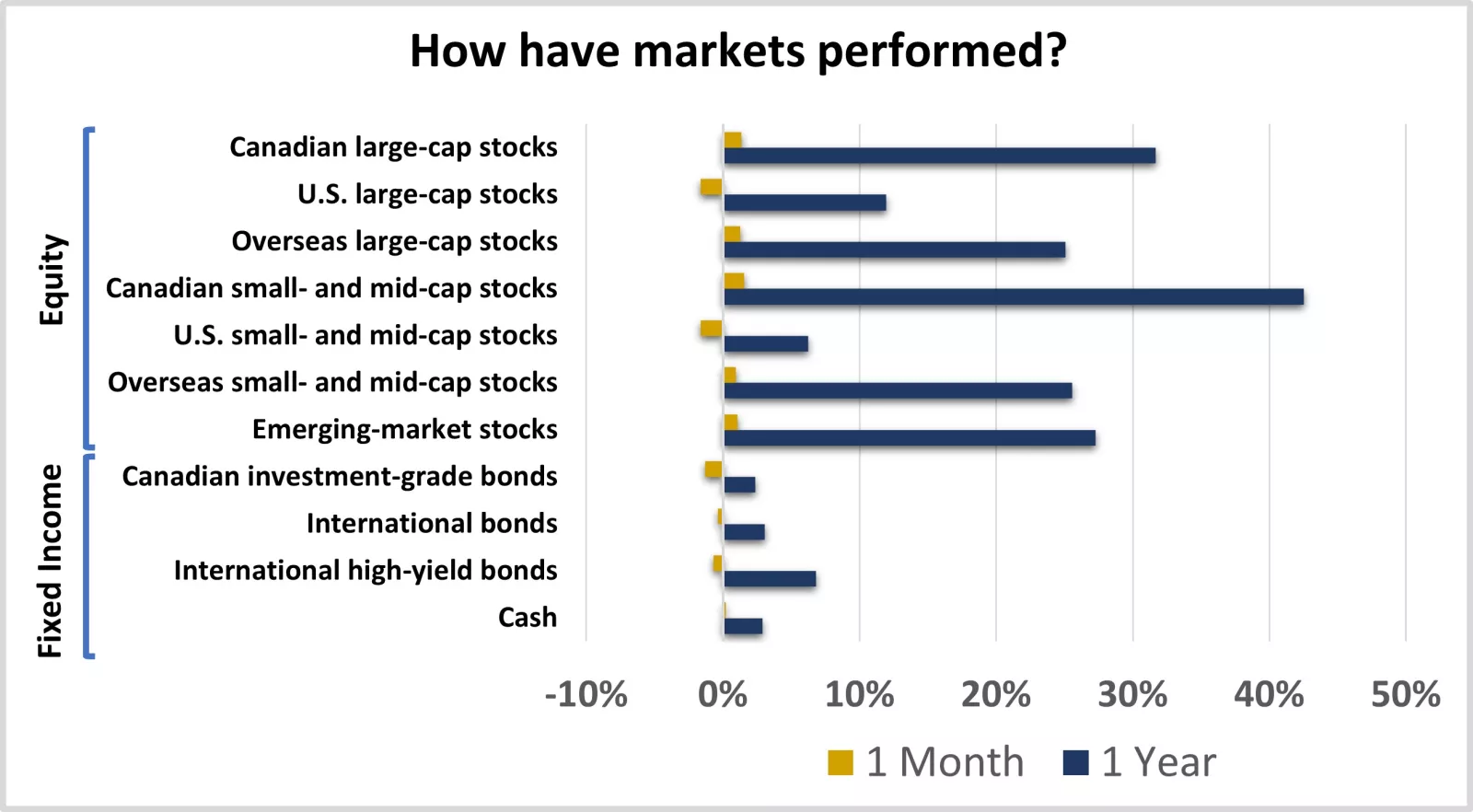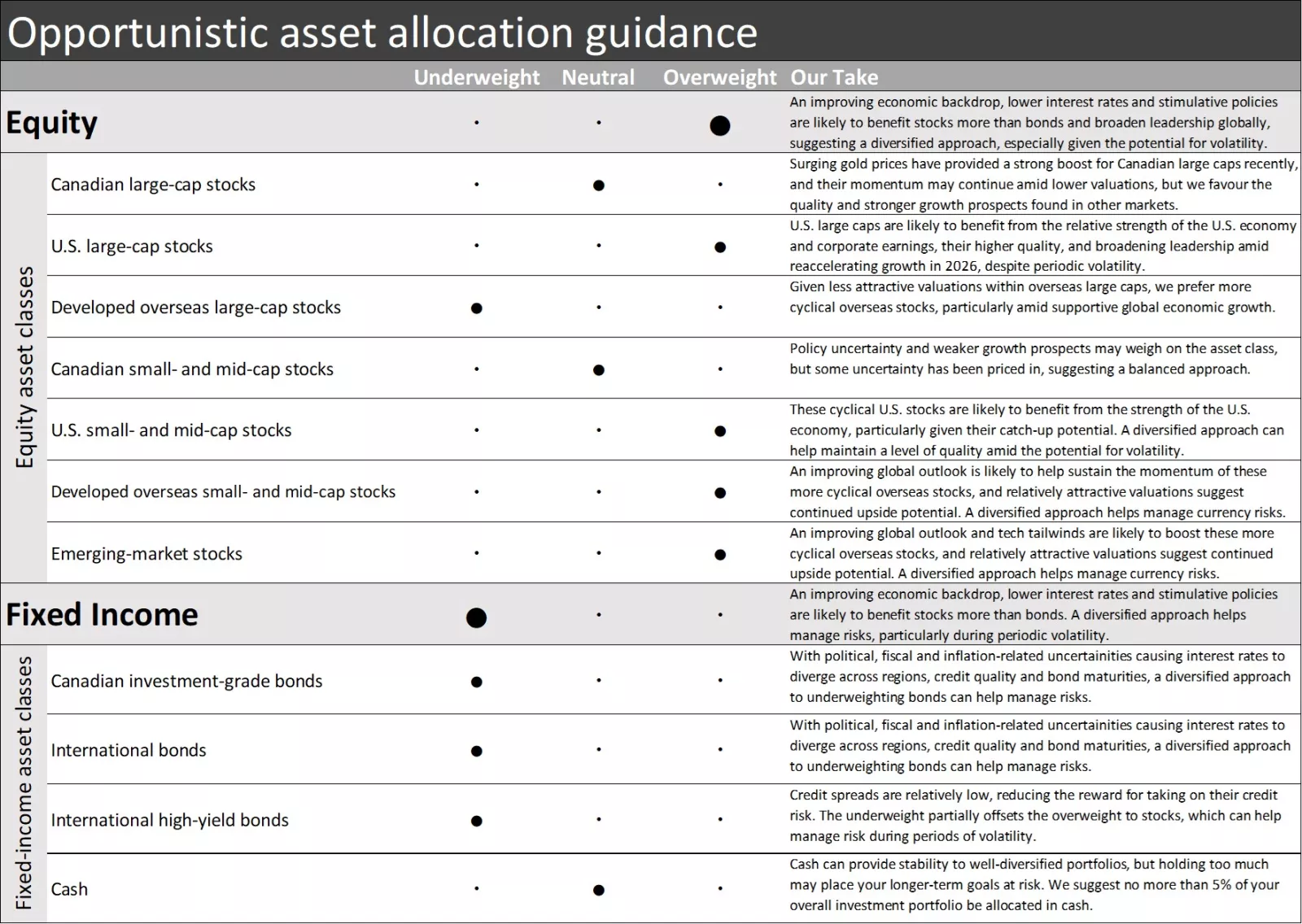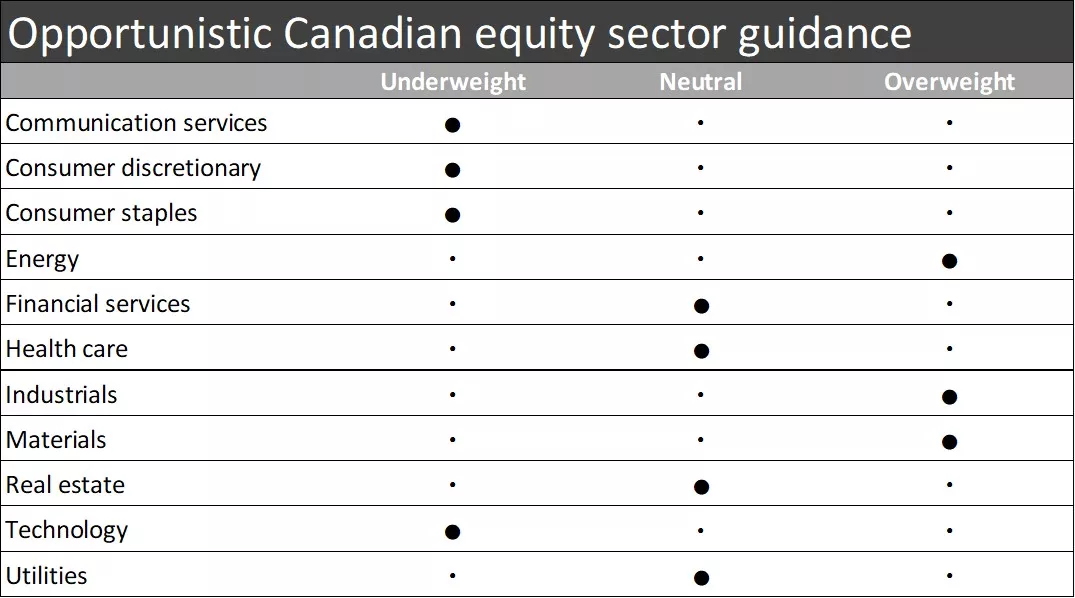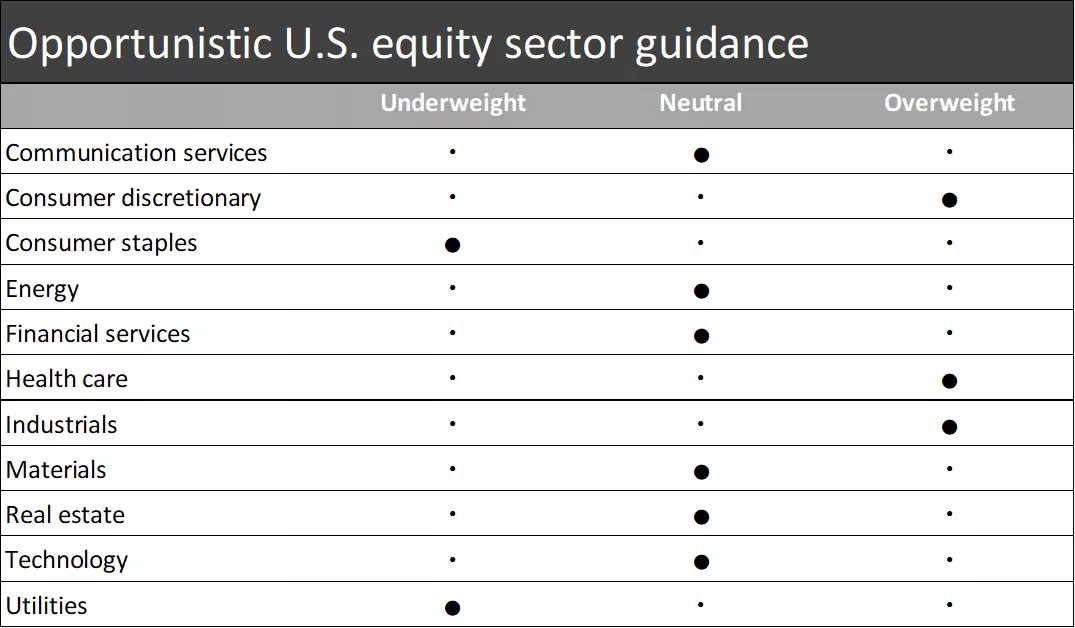Monthly portfolio brief
What stands out following a stand-out year?
What you need to know
- 2025 was a banner year for global markets, highlighting the importance of staying invested according to your longer-term strategy, including when times feel uncertain.
- The Canadian materials sector stood out, delivering a calendar-year total return greater than 100%, helping Canadian stocks dominate the leaderboard. Canadian small- and mid-cap stocks returned more than 40%.
- International stocks trailed but still posted solid returns, with the S&P 500 recording double-digit returns for the third straight year.
- With the stage set for another constructive year, we see opportunities across regions, market caps, and sectors. Navigate 2026 with confidence by prioritizing diversification and disciplined positioning.
- Stocks stand out, in our view, and we recommend overweighting. We see opportunities across domestic and international stock markets.
Portfolio tip
Portfolio overconcentration could impact the ability of a portfolio to achieve its risk and return objectives. Rebalancing helps maintain alignment and avoid surprises in a portfolio's performance.

This chart shows the performance of equity and fixed-income markets over the previous month and year.

This chart shows the performance of equity and fixed-income markets over the previous month and year.
Where have we been?
The final quarter's gains capped a year of resilience and growth. Steady economic momentum, solid corporate profits, and fresh central bank rate cuts powered markets in the fourth quarter, offsetting headwinds from a record-long U.S. government shutdown, persistent inflation, and a cooling labour market. Markets dipped toward month-end, ultimately delivering mixed returns across asset classes in December.
Even so, final quarter's gains across nearly all asset classes capped a year marked by strong returns across global markets. The takeaway? Staying disciplined when uncertainty strikes matters. Your longer-term strategy remains your most reliable guide.
In a banner year for stock markets, Canadian and overseas stocks stood out. Canadian stocks and overseas equity across developed and emerging markets dominated in December, echoing the trend that defined 2025.
The year's stand-out performance from the materials sector—a 100% total return for the sector within Canadian large-cap stocks—helped Canadian stock markets soar far above the rest. Driven by its commodity exposure amid a rush to gold, Canadian small- and mid-cap stocks stood atop the year's leaderboard. With a return greater than 40% for the first time since 2009, they more than tripled the return of the top-performing U.S. asset class in 2025.
In overseas markets, fiscal stimulus and easing monetary policies helped drive their annual returns beyond 20%, more than double the top-performing U.S. asset class. AI-driven optimism gave tech-heavy regions an extra push, propelling emerging-market equity into the year's top spot among international stock asset classes.
U.S. stocks delivered another strong year, even if they trailed their peers. The S&P 500 index recorded an annual return above 12% for the third consecutive year. Impressively, its three-year annualized return stands at 23%—notably exceeding the 10-year average of about 14%. Technology and growth sectors led the charge, with some generating around 40% average annual returns over three years in U.S. dollar terms.
For Canadian investors, the U.S. dollar weakness dampened returns from U.S. stocks in 2025. U.S. large-cap stocks returned about 18% in U.S. dollar terms, which is notably lower than the 12% return in Canadian dollar terms.
Canadian investment-grade bonds lag once again. Despite the Bank of Canada's four rate cuts in 2025 driving short-term rates lower, longer-term rates rose, helping cash outperform Canadian investment-grade bonds for the second year in a row. Benefiting from their yield advantage and contained credit spreads, international high-yield bonds were, once again, the top performing fixed-income asset class.
While all fixed-income asset classes have delivered positive returns over one- and three-year periods, five-year average annual returns across Canadian and international investment-grade bond markets continue to be negative, weakened by the spike in yields in 2022 that significantly pressured bond prices.
What do we recommend going forward?
To navigate 2026 with confidence, diversification will be key. Technology sectors have delivered outstanding performance in recent years. While AI's potential remains exciting, chasing performance has not proven to be a winning strategy. What's more, tech's strong run has led to increasingly concentrated markets—a risk that could spill into portfolios if unmanaged.
Importantly, as we outline in our 2026 Outlook , we believe the stage is set for a constructive year ahead, unlocking opportunities across regions, market caps, and sectors—making diversification a key strategy.
To position effectively, consider complementing tech and growth exposure with a combination of domestic and international investments, including value and cyclical parts of the market, anchored by with the mix of stocks and bonds most closely aligned with your goals. When supported by disciplined rebalancing, global diversification can help avoid overconcentration and keep your portfolio focused on what matters most.
Stocks stand out as a key opportunity—we see attractive potential domestically and internationally. With a constructive backdrop supported by lagging impacts of looser monetary policies, tech innovation, and the prospect of accelerating earnings growth across multiple markets, we view stocks favourably.
Accordingly, we recommend overweighting stocks, maintaining a healthy mix of timely positioning to further avoid overconcentration. Consider overweighting:
- Cyclical international stocks. Policy tailwinds and resilient global growth are likely to provide a boost to emerging-market stocks and overseas developed small- and mid-cap stocks. Emerging-market stocks also tend to do well during Federal Reserve rate-cutting cycles and can help portfolios capture tech exposure in global markets with favourable valuations.
- U.S. stocks. When allocating across small-, mid-, and large-cap stocks, U.S. stocks can help portfolios capture exposure to the AI theme and cyclical sectors with room to catch up, particularly given our expectation for a supportive economy, the Federal Reserve lowering interest rates another time or two in 2026, and broader earnings growth.
- Select Canadian stock sectors - industrials, energy, and materials. These sectors carry compelling valuations, particularly amid supportive infrastructure spending, rising demand for power, and higher gold prices.
- Select U.S. stock sectors - industrials, consumer discretionary, and health care. These sectors are likely to benefit from steady economic conditions, further innovation and buildout of AI capabilities across industries, fading policy risks and favourable valuations.
Bonds still matter, despite our underweight view. They stand out for investors seeking income, greater portfolio stability, and diversification benefits when paired with stocks. Consider their role in your portfolio. In today's environment, we recommend bond investors:
- Favour intermediate- and long-term bonds within Canadian investment-grade bond allocations. We expect 10-year Canadian government bond yields to remain largely rangebound around 3%-3.5% in 2026, offering attractive income relative to short-term bonds. With the Bank of Canada likely holding policy rates near 2%-2.5%, short-term yields remain constrained, making intermediate- and long-term bonds appealing for locking in higher yields.
- Invest worldwide. With the potential for interest rate volatility as markets evaluate the path of inflation, labour markets and monetary policies, we suggest diversified bond exposures. While Canadian bonds are core to a fixed-income portfolio, international exposures can help manage interest-rate and credit risks more globally.
- Put excess cash to work. Holding too much cash comes with opportunity costs. Putting excess cash to work in allocations that have become too underweight to unlock greater long-term return potential and more closely align your portfolio with your financial goals.
We're here for you
2025 was a stand-out year by many measures, rewarding disciplined investors. As exciting as the returns were, the rearview mirror is limited in what it can do in helping you find the opportunities that stand out with your portfolio, particularly when it comes to making progress toward your goals. Talk with your financial advisor about the attractiveness of diversification and the potential to broaden the horizons of your portfolio.
If you don’t have a financial advisor, we invite you to meet with an Edward Jones financial advisor to explore the potential of 2026 – a year where AI and innovation matter, but so will diversification.
Strategic portfolio guidance
Defining your strategic investment allocations helps to keep your portfolio aligned with your risk and return objectives, and we recommend taking a diversified approach. Our long-term strategic asset allocation guidance represents our view of balanced diversification for the fixed-income and equity portions of a well-diversified portfolio, based on our outlook for the economy and markets over the next 30 years. The exact weightings (neutral weights) to each asset class will depend on the broad allocation to equity and fixed-income investments that most closely aligns with your comfort with risk and financial goals.
Diversification does not ensure a profit or protect against loss in a declining market.

Within our strategic guidance, we recommend these asset classes:
Equity diversification: Canadian large-cap stocks, U.S. large-cap stocks, developed overseas large-cap stocks, Canadian small- and mid-cap stocks, U.S. small- and mid-cap stocks, developed overseas small- and mid-cap stocks, emerging-market stocks.
Fixed-income diversification: Canadian investment-grade bonds, international bonds, international high-yield bonds, cash.

Within our strategic guidance, we recommend these asset classes:
Equity diversification: Canadian large-cap stocks, U.S. large-cap stocks, developed overseas large-cap stocks, Canadian small- and mid-cap stocks, U.S. small- and mid-cap stocks, developed overseas small- and mid-cap stocks, emerging-market stocks.
Fixed-income diversification: Canadian investment-grade bonds, international bonds, international high-yield bonds, cash.
Opportunistic portfolio guidance
Our opportunistic portfolio guidance represents our timely investment advice based on current market conditions and a shorter-term outlook. We believe incorporating this guidance into a well-diversified portfolio may enhance your potential for greater returns without taking on unintentional risks, helping to keep your portfolio aligned with your risk and return objectives. We recommend first considering our opportunistic asset allocation guidance to capture opportunities across asset classes. We then recommend considering opportunistic equity sector and Canadian investment-grade bond guidance for more supplemental portfolio positioning, if appropriate.

Our opportunistic asset allocation guidance is as follows:
Equity —overweight overall; underweight — Developed overseas large-cap stocks; neutral — Canadian large-cap stock and Canadian small- and mid-cap stocks; Overweight — U.S. large-cap stocks, U.S. small- and mid-cap stocks, developed overseas small- and mid-cap stocks, and emerging-market stocks.
Fixed income —underweight overall; underweight – Canadian investment-grade bonds, international bonds, and international high-yield bonds; neutral — Cash.

Our opportunistic asset allocation guidance is as follows:
Equity —overweight overall; underweight — Developed overseas large-cap stocks; neutral — Canadian large-cap stock and Canadian small- and mid-cap stocks; Overweight — U.S. large-cap stocks, U.S. small- and mid-cap stocks, developed overseas small- and mid-cap stocks, and emerging-market stocks.
Fixed income —underweight overall; underweight – Canadian investment-grade bonds, international bonds, and international high-yield bonds; neutral — Cash.

Our opportunistic Canadian equity sector guidance follows:
Overweight for energy, industrials, and materials
Neutral for financial services, health care, real estate, and utilities
Underweight for communication services, consumer discretionary, consumer staples, and financial services and technology

Our opportunistic Canadian equity sector guidance follows:
Overweight for energy, industrials, and materials
Neutral for financial services, health care, real estate, and utilities
Underweight for communication services, consumer discretionary, consumer staples, and financial services and technology

Our opportunistic U.S. equity sector guidance follows:
• Overweight for consumer discretionary, health care, and industrials
• Neutral for communications services, financial services, energy, real estate, technology and materials
• Underweight for consumer staples and utilities

Our opportunistic U.S. equity sector guidance follows:
• Overweight for consumer discretionary, health care, and industrials
• Neutral for communications services, financial services, energy, real estate, technology and materials
• Underweight for consumer staples and utilities

Our opportunistic Canadian investment-grade bond guidance is overweight in interest rate risk (duration) and neutral in credit risk.

Our opportunistic Canadian investment-grade bond guidance is overweight in interest rate risk (duration) and neutral in credit risk.
Tom Larm, CFA®, CFP®
Tom Larm is a Portfolio Strategist on the Investment Strategy team. He is responsible for developing advice and guidance related to portfolio construction, asset allocation and investment performance to help clients achieve their long-term financial goals.
Tom graduated magna cum laude from Missouri State University with a bachelor’s degree in finance. He earned his MBA from St. Louis University, is a CFA charter holder and holds the CFP professional designation. He is a member of the CFA Society of St. Louis.
Important information
Past performance of the markets is not a guarantee of future results.
Diversification does not ensure a profit or protect against loss in a declining market.
Investing in equities involves risk. The value of your shares will fluctuate, and you may lose principal. Mid- and small-cap stocks tend to be more volatile than large-company stocks. Special risks are involved in international and emerging-market investing, including those related to currency fluctuations and foreign political and economic events.
Rebalancing does not guarantee a profit or protect against loss and may result in a taxable event.
Before investing in bonds, you should understand the risks involved, including credit risk and market risk. Bond investments are also subject to interest rate risk such that when interest rates rise, the prices of bonds can decrease, and the investor can lose principal value if the investment is sold prior to maturity.
The opinions stated are as of the date of this report and for general information purposes only. This information is not directed to any specific investor or potential investor and should not be interpreted as specific recommendations or investment advice. Investors should make investment decisions based on their unique investment objectives and financial situation.
